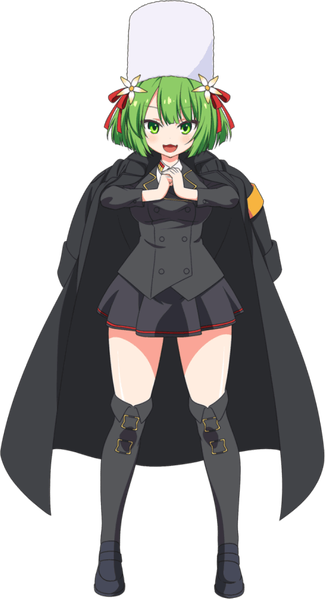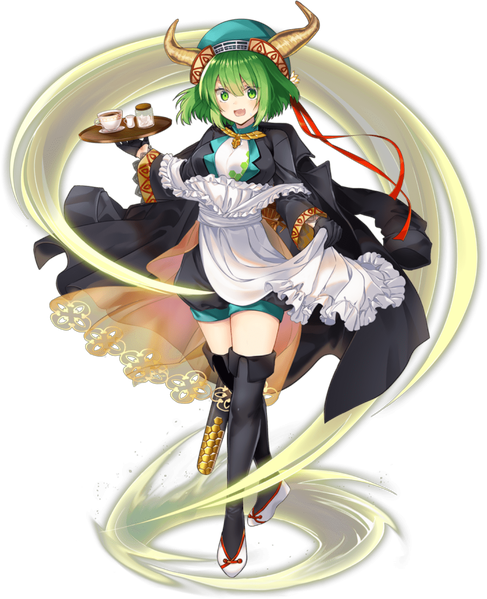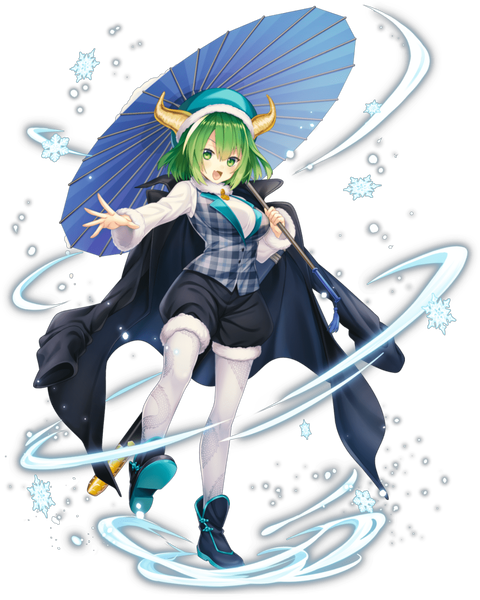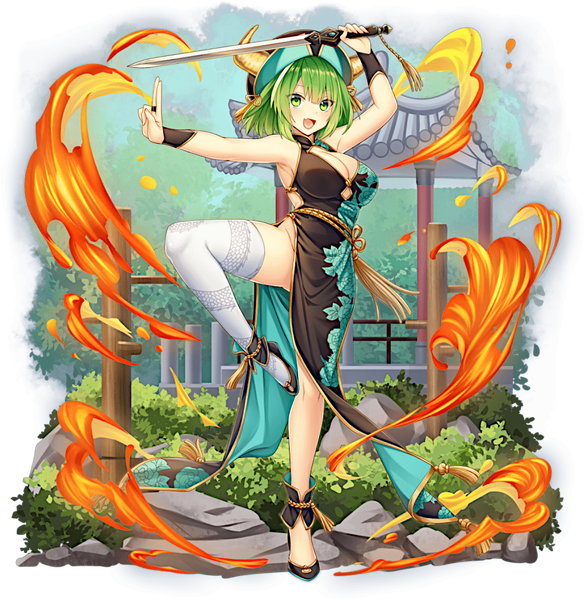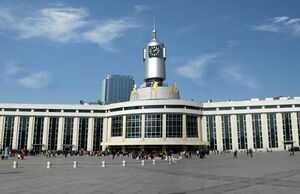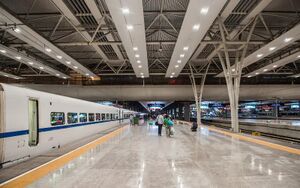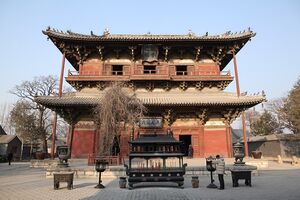Tianjin
| Tianjin | |||||
|---|---|---|---|---|---|
| Japanese Name | テンシン | ||||
| Weapon | |||||
| Race | Human | ||||
| Nationality | |||||
| Birthday | October 3 | ||||
| Constellation | Libra | ||||
| Talents | Cooking, Martial arts, Drawing | ||||
| Likes | Beijing, Xiaolongbao, Steamed jiaozi | ||||
| Dislikes | People that make fun of other's upbringing or birthplace | ||||
| Strengths | Taking care of her teammates | ||||
| Weaknesses | Believing everything | ||||
| Hobbies | Drawing pictures and making manhua | ||||
The name's Tianjin. I am the Bo-shi's assistant. And by assistant, I mean that I make all the food and protect Bo-shi from bad guys. Oh, and by Bo-shi, I mean Beijing Bo-shi, who's also part of the SSS. Wherever you find Bo-shi, you'll find me too!
Layers
| Icon | Title | Release Date | Where to Obtain |
|---|---|---|---|
| [Valet Who Can't Clean] Tianjin | 2021 October 14 (EN) | [Altar of Judgement - Helmed Warrior] Event Reward | |
| [Blissful Moment] Tianjin | 2022 March 1 (EN) | [Lippia Giant Monster] Pick Up Gacha, Premium Gacha | |
| [Naïve Snow Games] Tianjin | 2021 November 30 | [Magical School Trip in the Town of Ash] Pick Up Gacha, Premium Gacha | |
| [Secret Base's Hero] Tianjin | 2021 October 14 (EN) | [Full of Life! Chinese Girl] Limited Gacha | |
| [Burning Creative Spirit] Tianjin | 2023 July 31 | Premium Gacha | |
| [Comfy Valentine] Tianjin | 2023 January 31 | [The Sickness Unto Chocolate] Limited Gacha |
Owned Skills
Trivia
- Tianjin's birthday is the reopening date of Tianjin railway station rebuilt in 1987.
- Tianjin's first debut was a voiced NPC in the story of Beijing (Kind Scholar) where she graduated from the "Secret Base" orphanage. Tianjin is Beijing's bodyguard and research assistant who's formerly an orphan under Tianjin from the orphanage called the Secret Base. The "Secret Base" is likely a reference to the early Tianjin station, aka "Old Dragon Head" railway station being used as a base during the Boxer Rebellion incident in June 1900.
- Tianjin's sword art style, and her former nickname "Xiaolong" before Beijing's given name to her as Tianjin, is a direct homage to the fictional character Xiaolongnü, female protagonist of the wuxia novel, The Return of the Condor Heroes, by Jin Yong. Xiaolongnü's iconic sword art is called the Swordplay of Jade Maiden (玉女素心劍法).
- The real life Tianjin Station's entrance motifs can be seen on the hat band in the outfits of [Blissful Moment] and [Secret Base's Hero].
- Xiaolongbao (小笼包) is a soup dumpling, tangbao (Chinese 汤包) of Jiangsu cuisine traditionally prepared in a xiaolong, steamed in a small bamboo steaming basket, hence the name.
- Jiaozi can be seen in the art of [Secret Base's Hero]. Jiaozi (饺子/餃子) are Chinese dumplings made with ground meat and/or vegetable filling wrapped into a thinly rolled piece of dough, commonly eaten in China and other parts of East Asia. Jiaozi are folded to resemble Chinese sycee and have great cultural significance attached to them within China.
- Tianjin's liking for drawing and artwork can be a reference to the oil painting mural drawn by Qin Zheng inside the south entrance hall of Tianjin station.
- The building silhouette in the background of [Secret Base's Hero] is the tip of Guanyin Pavilion of Dule Temple.
- Hualongdianjing Jian literally means "Finishing the art of a dragon by dotting its eye, Sword", Hualongdianjing (画龙点睛) is a Chinese proverb meaning "finishing touches".
Counterpart
The Tianjin railway station (Chinese: 天津站; pinyin: Tiānjīn Zhàn) is the principal railway station in Tianjin, China. It was established in 1888, rebuilt in 1987-1988, and restructured in 2007-2008. Its Chinese big title was written by Deng Xiaoping in 1988, for celebrating 100th anniversary of its founding. In 1888, the Kaiping Tramway and Imperial Railways of North China was extended to Tianjin and was subsequently renamed as the Jintang Railway (津唐铁路) and became the first Train station completed in China at the time. Construction of the railroad had begun in 1886 and was situated near the Hai River. In May 1891, a larger station was built 500 metres to the west and a civil structure contained a three-storey building.
After the Chinese economic reform, the burden of transportation on the Tianjin Station increased due to the sharp increase in passenger traffic; the average daily number of passengers was 65,000. Starting on 15 April 1987, thorough renovation work was conducted on the Tianjin railway station. New roofing was constructed on the original site of the old station house and also on the 66-metre-high (217 ft) cylindrical clock tower, face Hai River. The construction work was completed on 25 September 1988. On the eve 1 October of that same year, which was the centenary of the establishment of the Tianjin Station, the then Minister of Railways Li Senmao (李茂森) cut the ribbon and officially opened the new station building of the Tianjin Station.
In the spring of 1988, Li Ruihuan, then the Tianjin mayor, inspired by the Sistine Chapel ceiling during his visit to Italy, ordered to paint a similar dome mural for the entrance hall of the station. It took four months to complete the mural before October 1, the National Day of 1988, by old painter Qin Zheng (秦征) and his students. The subject of the mural is "Jingwei Tries to Fill the Sea", in a Baroque style depiction of a figure in Chinese mythology. Jingwei was depicted as a naked woman with two wings and long hair, which broke the taboo concerning nudity for the first time after the Culture Revolution. It was once the biggest Dome Mural in China. In order to protect the oil painting, Tianjin Railway station became the China's first public place to forbid smoking. At present, the Tianjin railway station includes the Beijing–Tianjin Intercity Railway and the North station railway. The elevated waiting room, underground pit room, high platform canopy, passenger tunnel, and line package channels have a total construction area of 185,000 square metres. Wikipedia
The Dule Temple (獨樂寺/独乐寺; pinyin: Dúlè Sì) is a Buddhist temple located in Jizhou District of suburban Tianjin, China. The temple is of historical as well as architectural significance. Its oldest surviving buildings are two timber-frame structures, the front gate and the central hall (pavilion) that houses a colossal clay statue of the Eleven-Headed manifestation of the Bodhisattva Guanyin (Avalokiteśvara). Both structures date back to the Liao dynasty and are among the oldest surviving wooden buildings in China.
The origins of the Dule Temple date back at least to the early Tang dynasty. However, no buildings from the Tang dynasty era have survived on the site. The oldest buildings still in existence, the Shan Gate and the Guanyin Pavilion, were constructed during a renovation of the temple in the second year of Tonghe Emperor of the Liao dynasty (984 AD). These buildings, both central features of the temple, were designed and constructed by local architects and craftsmen on the basis of the Tang architectural technology and carving techniques.[3]
In 755, An Lushan held a rally in the Dule Temple at the onset of his rebellion against the Tang emperor. The name of the temple could be a reference to An Lushan, who was also known as An Dule. However, the name could also have originated from the Dule River that flows to northwest of the city, although it is not clear if the river's name predates that of the temple. In 1928, a unit of soldiers commanded by warlord Sun Dianying was stationed in the Dule Temple and used the main hall as barracks. Sun Dianying and his troops were responsible for the looting of the nearby Eastern Qing Tombs. A leftover from the military occupation of the temple are bullet holes in the timber frames that were inflicted during target practice. In the early 1930s, Dule Temple was studied by Liang Sicheng, the author of the China's first modern history on Chinese architecture. In the same decade, the temple was converted into the Jixian Village Normal School.
The Guanyin Pavilion (觀音閣/观音阁; pinyin: Guānyīn Gé) is a three-story timber structure with five single-eaves Xieshan roofs (歇山頂/歇山顶; pinyin: Xiēshān Dǐng). The pavilion has a height of about 23 meters and consists of more than one thousand individual pieces. Inside the hall there is a clay statue of the Eleven-Headed Guanyin (十一面觀音/十一面观音; pinyin: Shíyīmiàn Guānyīn). The statue, measuring 16 meters in height, is the biggest of its kind in China. This statue of Guanyin was constructed in the Liao dynasty (907-1125), but the artistic style is similar to that in the flourishing period of the Tang dynasty (618-907). On both sides of the statue of Guanyin are statues of his attendants, also made in the Liao dynasty. The pavilion centers with the statue of Guanyin and has two rows of column pillars around. The design which sets dougong on the pillars and architraves on the dougong in each layer separates the pavilion into three stories and makes it easier for people to pay tribute to Guanyin from different angles. Wikipedia
Map
Gallery
- Pages using Tabber parser tag
- Pages using DynamicPageList3 parser tag
- Weapon Sword
- Human
- Eisengrad
- Libra
- Element Cut
- Element Fire
- Element Light
- Element Dark
- Element Water
- Train Knights
- China

